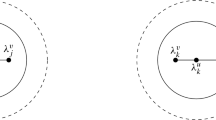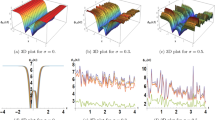Abstract
The soliton solution of the ultradiscrete BKP equation is obtained, via ultradiscretization of the generalized discrete BKP equation. It is shown that these solutions consist of three different kinds of soliton solutions for the ultradiscrete BKP equation. We also derive the soliton solution of the B-type box and ball system by taking the reduction of the ultradiscrete BKP equation and clarify the origin of the two types of soliton solutions of the B-type box and ball system.




Similar content being viewed by others
References
Wolfram, S. (ed.): Theory and Applications of Cellular Automata. World Scientific, Singapore (1986)
Takahashi, D., Satsuma, J.: A soliton cellular automaton. J. Phys. Soc. Jpn. 59, 3514–3519 (1990)
Matsukidaira, J., Satsuma, J., Takahashi, D., Tokihiro, T., Torii, M.: Toda-type cellular automaton and its $N$-soliton solution. Phys. Lett. A 225, 287–295 (1997)
Tsujimoto, S., Hirota, R.: Ultradiscrete KdV equation. J. Phys. Soc. Jpn. 67, 1809–1810 (1988)
Tokihiro, T., Takahashi, D., Matsukidaira, J., Satsuma, J.: From soliton equations to integrable cellular automata through a limiting procedure. Phys. Rev. Lett. 76, 3247–3250 (1996)
Tokihiro, T., Takahashi, D., Matsukidaira, J.: Box and ball system as a realization of ultradiscrete nonautonomous KP equation. J. Phys. A Math. Gen. 33(2000), 607–619 (2000)
Hirota, R.: Discrete analogue of a generalized Toda equation. J. Phys. Soc. Jpn. 50, 3785–3791 (1981)
Miwa, T.: On Hirota’s difference equations. Proc. Jpn. Acad. Ser. A. Math. Sci. 58, 9–12 (1982)
Shinzawa, N.: Soliton solution to the generalized discrete BKP equation and its Bäcklund transformation equations. Jpn. J. Ind. Appl. Math. 35, 915–937 (2018)
Nagai, H.: Mixed type soliton solution of the B type box and ball system (in Japanese). Rep. RIAM Symp. 25AO–S2, 65–70 (2014)
Nagai, H., Takahashi, D.: Bilinear equations and Bäcklund transformation for a generalized ultradiscrete soliton solution. J. Phys. A Math. Theor. 43, 375202 (2010)
Author information
Authors and Affiliations
Corresponding author
Additional information
Publisher's Note
Springer Nature remains neutral with regard to jurisdictional claims in published maps and institutional affiliations.
Appendix A: Transformation
Appendix A: Transformation
We shall derive (4) from
which is a soliton solution of (1) given in [9]. Here \(t_i^{(k_i)}\) and \(c_i^{(k_i)}\) are arbitrary parameters, \(\phi (t)\) and cf(t, s) are defined by (5) and (8). Using the gauge transformation, that is, by multiplying (A.1) with
we have another form of soliton solution,
Note that the term associated with
in (A.2) is expressed by
If we replace free parameters \(c_i\) as
then (A.3) is reduced to
since \(cf(t, s)=-cf(s, t)\) and
About this article
Cite this article
Nagai, H., Shinzawa, N. Mixed soliton solutions for the ultradiscrete BKP equation and its reduction. Japan J. Indust. Appl. Math. 39, 777–800 (2022). https://doi.org/10.1007/s13160-022-00506-1
Received:
Revised:
Accepted:
Published:
Issue Date:
DOI: https://doi.org/10.1007/s13160-022-00506-1




